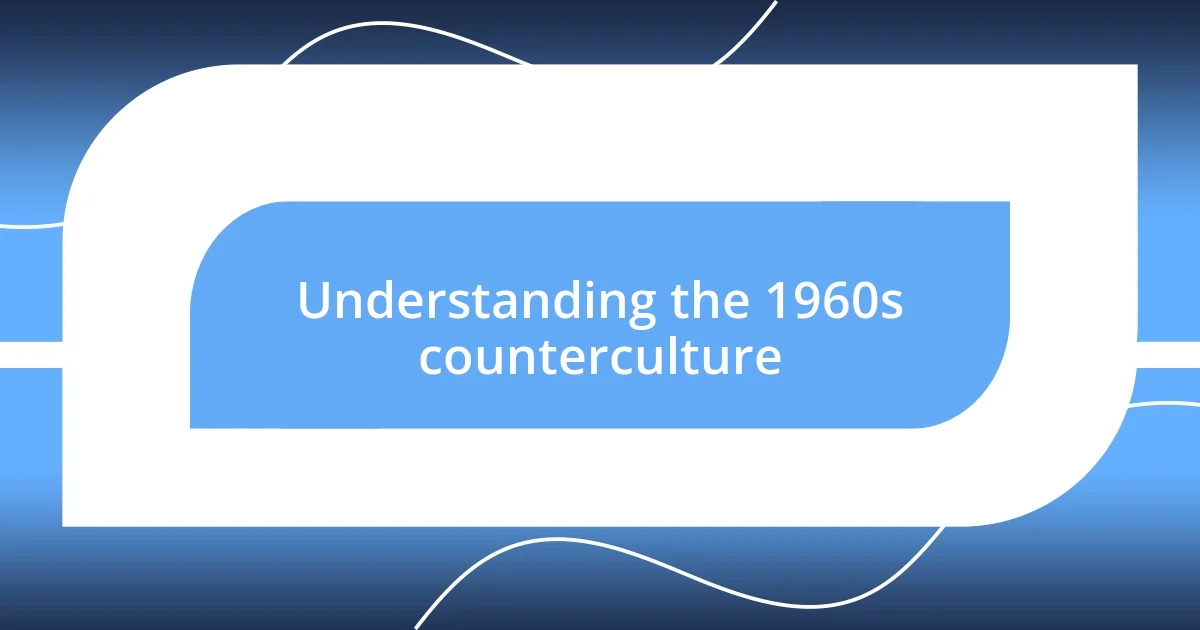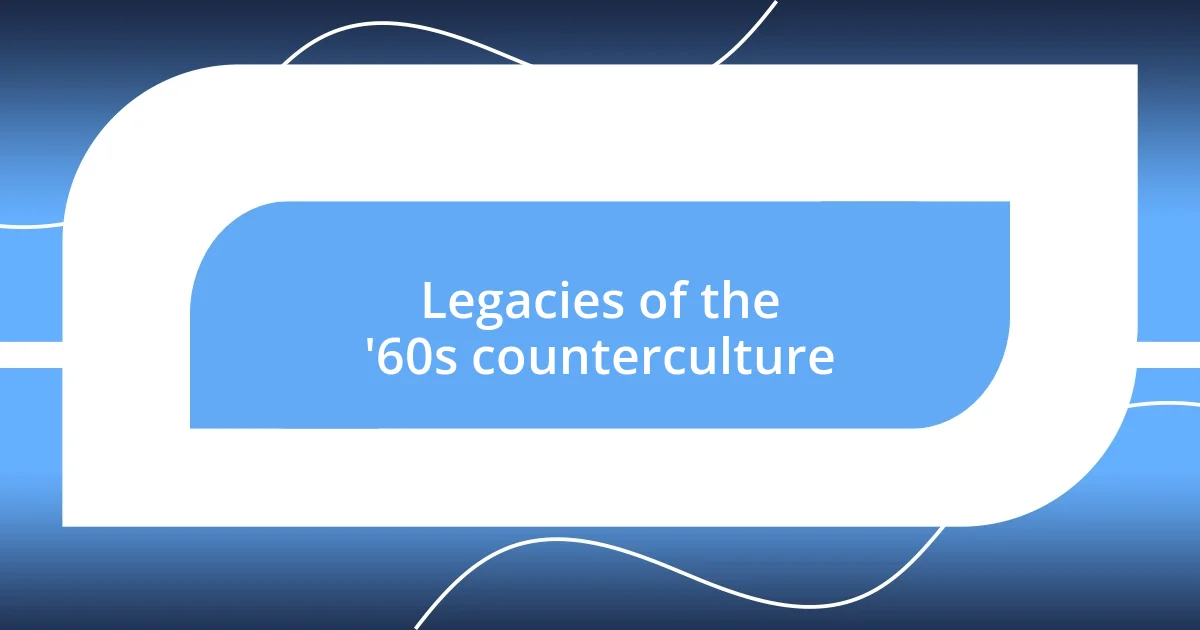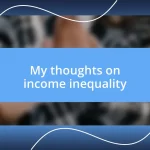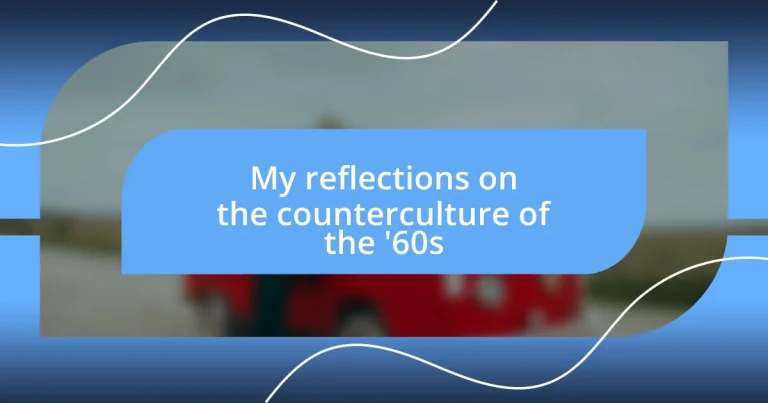Key takeaways:
- The 1960s counterculture was a response to societal norms, emphasizing freedom, peace, and community through music and protests.
- Art movements like Pop Art, Psychedelic Art, and Street Art emerged, using creative expressions to challenge cultural conventions and address social issues.
- Significant social movements, including the Civil Rights Movement and the Environmental Movement, highlighted the importance of collective action for social justice and equality.

Understanding the 1960s counterculture
The 1960s counterculture emerged as a powerful reaction against societal norms, fueled by a desire for freedom and authenticity. I often wonder how it must have felt to be young during that time, to stand amidst protests and witness a shift toward more liberal values. Imagine the thrill of discovering new music that championed peace and love, like the sounds of The Beatles and Bob Dylan.
Many individuals were drawn into this movement, seeking a sense of belonging and purpose. I remember hearing stories from my parents about their own experiences at music festivals, where they felt an irresistible sense of liberation and community. These gatherings weren’t just concerts; they were places where people could express their individuality and challenge the status quo.
The counterculture also confronted deep-rooted issues around civil rights and war. It’s intriguing to reflect on how young people, emboldened by their ideals, rallied together to advocate for social change. How powerful it must have been to hold a sign for peace, feeling that collective energy—a tangible reminder that their voices truly mattered in shaping the future.

Art movements of the counterculture
Art movements during the counterculture period of the 1960s reflected both the vibrant spirit of rebellion and a quest for deeper meaning. I find it fascinating how artists such as Andy Warhol and the growing Pop Art movement transformed mundane commercial imagery into statements of cultural critique. This was not just about aesthetics; it resonated with my belief that art should provoke thought and challenge norms.
As I dive deeper into this era, I can’t help but appreciate the influence of psychedelic art, characterized by swirling colors and surreal imagery. This style often accompanied the music of the time, creating an immersive experience for concertgoers. I recall flipping through old record covers, marveling at how these artworks captured the essence of the music while inviting viewers into a trance-like state of mind.
Moreover, street art and graffiti began to emerge as powerful forms of expression. Artists like Keith Haring used public spaces to communicate social issues, turning cityscapes into canvases for change. I often think about the emotional weight of seeing such art in vibrant colors, each piece telling a story of struggle and hope. It reminds me that art is not just for galleries; it’s alive in the streets, speaking to those who dare to listen.
| Art Movement | Description |
|---|---|
| Pop Art | Focused on commercial culture and consumerism, using imagery from advertisements and popular media. |
| Psychedelic Art | Characterized by vivid colors, dreamlike visuals, often associated with the music of the era. |
| Street Art | An accessible form of expression that addresses social issues and challenges authority, often seen outside galleries. |

Social movements that emerged
Social movements in the 1960s blossomed as young people united under shared ideals, driven by a need for activism and change. I often think about my aunt, who eagerly shared her tales of marching for civil rights, her voice filled with passion and conviction. The energy radiating from those collective actions must have been electric, as individuals found strength in togetherness, challenging societal injustices and demanding equality.
Here are some significant movements that emerged during this period:
- Civil Rights Movement: Focused on ending racial discrimination and inequality, advocating for African American rights.
- Anti-Vietnam War Movement: Challenged U.S. involvement in Vietnam, mobilizing protests across the nation.
- Women’s Liberation Movement: Fought for gender equality, including reproductive rights and workplace opportunities.
- Environmental Movement: Advocated for nature conservation and awareness of pollution, laying groundwork for future activism.
- Gay Rights Movement: Emerged to combat discrimination against LGBTQ+ individuals, seeking equal rights and societal acceptance.
Reflecting on these movements, I can’t help but feel inspired by those brave enough to speak out. It’s a powerful reminder that social progress often springs from the determination of individuals demanding a better world.

Legacies of the ’60s counterculture
The legacies of the ’60s counterculture resonate deeply in today’s society. For me, the ideals of peace and love continue to inspire movements advocating for social justice. I remember attending a local Peace Day rally, where the energy felt reminiscent of that 1960s fervor; it was as if the spirit of that time had come alive again, reminding us that the struggle for equality isn’t just historical—it’s ongoing.
One striking legacy is the birth of environmental awareness, which emerged from the counterculture’s rebellion against industrialism. I often reflect on how the ethos of caring for the Earth was woven into the fabric of protests and festivals. When I attended an eco-festival last summer, it was heartening to see so many people, across generations, sharing the same passion for sustainability rooted in those revolutionary thoughts from the ’60s.
Additionally, the music of that era laid a cultural foundation that influences artists and activists today. I can’t help but play old vinyl records of folk and rock that moved the masses back then; the messages still provoke thought and inspire action. How could we forget the anthems that echoed through the streets, reminding us to raise our voices? Each time I listen, I feel connected to that collective courage, reaffirming the belief that music remains a powerful tool to unite and energize those who dare to dream of a better world.

Lessons for today’s society
The lessons from the counterculture of the ’60s resonate profoundly in our contemporary society. When I think about the relentless pursuit of justice displayed during that time, it encourages me to stay engaged in current social issues. Am I doing enough to advocate for causes I care about? Sometimes I find myself reflecting on that question, realizing that even small efforts, like volunteering or spreading awareness through social media, can contribute to larger movements.
One striking takeaway is the power of unity. The way diverse groups came together to stand up for civil rights and against the war illustrates that collective action can drive change. I often recall an inspiring community gathering I attended, where voices from various backgrounds merged to demand better environmental policies. It struck me how every person there, regardless of their story, shared a common goal. Could we replicate that energy today? I believe it’s essential for us to foster those connections, embracing our differences while championing causes that matter to all of us.
Finally, the emphasis on self-expression and creativity from the ’60s serves as a vital lesson. I remember picking up a paintbrush during a local art initiative promoting mental health awareness. The experience wasn’t just therapeutic; it mirrored the spirit of free expression that the counterculture championed. How can we incorporate more creativity into activism? I think that when we allow ourselves to be vulnerable and share our stories, it cultivates a deeper understanding and connection within our communities, sparking inspiration and meaningful dialogue.














